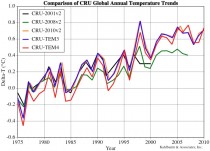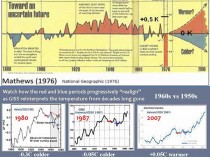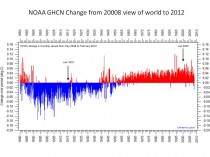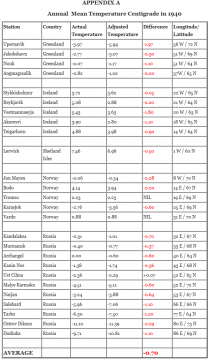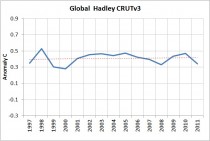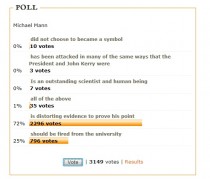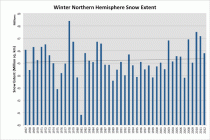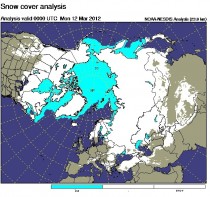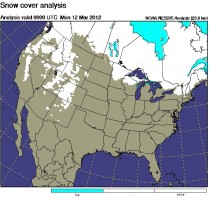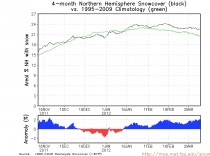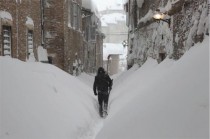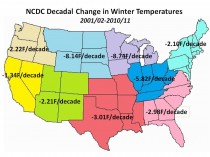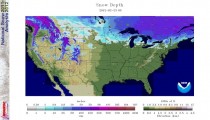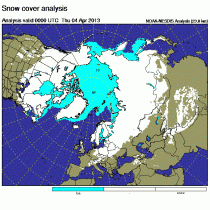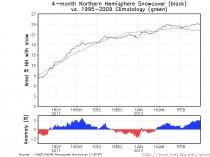A federal judge in Mississippi has ended a long-running suit that attempted to hold a selection of U.S. utilities and coal and oil companies responsible for flooding damage caused by Hurricane Katrina.
U.S. District Judge Louis Guirola Jr., in a decision released yesterday, dismissed Comer vs. Murphy Oil with prejudice, meaning it can’t be refiled or reconstituted. The decision should serve to preclude, other similar lawsuits accusing companies of emitting global-warming gases that cause damaging weather patterns.
Guirola dismissed the case for legal reasons - he’d already dismissed it once before, and he said the plaintiffs were barred by various legal doctrines from reviving it - but “out of an abundance of caution” he reiterated why the case shouldn’t be allowed to proceed.
Those reasons are becoming familiar in global-warming cases: Guirola ruled the case invalid because the underlying issue of global warming is a political question, best left to the legislative branch and regulators to decide. And because existing tort law requires plaintiffs to prove a more solid connection between their injuries and the actions of those they are suing than a scientifically plausible argument that one contributed to the other.
Plaintiff lawyers have tried various ways to fit global warming into conventional tort law, where they can construct a case showing industry executives were aware of the threat of CO2 emissions and did nothing about it. That would allow them to make the argument that the industry exposed others to “unreasonable” risks. The evidence would be memos and other material showing they were aware of scientific links between CO2 and global warming, regardless of whether they believed them, much as the states pursued lawsuits against the tobacco industry by uncovering evidence executives were aware of research showing links to cancer and addiction.
Guirina wasn’t buying it, saying global warming was too complex an issue to ask a court to decide: “The plaintiffs are asking the Court, or more specifically a jury, to determine without the benefit of legislative or administrative regulation, whether the defendants’ emissions are “reasonable,’” he said.
The case followed an odd route after dismissal up to the Fifth Circuit, where a three-judge panel reinstated some of the claims, then an en banc panel agreed to rehear the appeal, only to dismiss the case when it couldn’t form a quorum of nine judges. The plaintiffs declined to appeal to the U.S. Supreme Court.
The decision helps close the door on global-warming litigation by private plaintiffs. The U.S. Supreme Court offered some hope to plaintiffs in 2007 when it held that Massachusetts could sue the E.P.A. for failing to enact rules to control CO2 emissions that threatened the state’s coastline. That seemed to affirm the basic idea that CO2 was a pollutant covered by the Clean Air Act. But the Supreme Court eased that door shut last year with Conn. v. AEP, where it said Connecticut must wait until or unless the EPA issues regulations before suing individual companies over emissions. The Ninth Circuit also dismissed a lawsuit by Inuit villagers against ExxonMobil and other companies, citing the political question doctrine.
The judge refused a request for sanctions against attorney F. Gerald Maples for refiling the case after it had been dismissed, saying he acted in “good faith” under a Mississippi law that might have, but didn’t, offer an extension of the statute of limitations.
By Anthony Watts with additions by Joe D’Aleo
Over at JunkScience.com Steve Milloy writes:
Skeptic Setback? ;New’ CRU data says world has warmed since 1998 But not in a statistically significant way.
Gerard Wynn writes at Reuters:
Britain’s Climatic Research Unit (CRU), which for years maintained that 1998 was the hottest year, has published new data showing warmer years since, further undermining a sceptic view of stalled global warming.
The findings could helpfully move the focus from whether the world is warming due to human activities - it almost certainly is - to more pressing research areas, especially about the scale and urgency of human impacts.
After adding new data, the CRU team working alongside Britain’s Met Office Hadley Centre said on Monday that the hottest two years in a 150-year data record were 2005 and 2010 - previously they had said the record was 1998.
None of these findings are statistically significant given the temperature differences between the three years were and remain far smaller than the uncertainties in temperature readings…
And Louise Gray writes in the Telegraph: Met Office: World warmed even more in last ten years than previously thought when Arctic data added
Some of the change had to do with adding Arctic stations, but much of it has to do with adjustment. Observe the decline of temperatures of the past in the new CRU dataset:
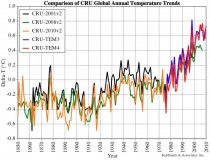
Enlarged
Data plotted by Kahlbaum/Wolff. This plot has saved versions (thanks to Craig Loehle) from 2001, 2008, downloaded versions from 2010, 20111 and the new HADCRUv4. Each iteration increases the trend by cooling the past and warming the present. Of course, this is just “business as usual” for the Phil Jones team.
Here is a close-up on more recent years, see how much warmer CRU3 and CRU4 in 2011, 2012 are than CRU3 in 2010. The 2011 and 2012 may be land only compilations. ironically they track well with the 2010 version until 1997 then diverge. More updates to follow.
On the other side of the pond, here’s the NASA GISS 1980 data set compared with the 2010 version. More cooling of the past.
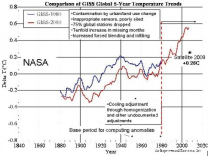
Enlarged
And of course there’s this famous animation where the middle 20th century got cooler as if by magic. Watch how 1934 and 1998 change places as the warmest year of the last century. This is after GISS applied adjustments to a new data set (2004) compared with the one in 1999
Hansen, before he became an advocate for protest movements and getting himself arrested said:
The U.S. has warmed during the past century, but the warming hardly exceeds year-to-year variability. Indeed, in the U.S. the warmest decade was the 1930s and the warmest year was 1934.
Source: Whither U.S. Climate?, By James Hansen, Reto Ruedy, Jay Glascoe and Makiko Sato - August 1999
In the private sector, doing what we see above would cost you your job, or at worst (if it were stock data monitored by the SEC) land you in jail for securities fraud. But hey, this is climate science. No worries.
And then there’s the cumulative adjustments to the US Historical Climatological Network (USHCN)

The result is a cooling of the past and a warming of recent data and thus an enhanced apparent warming trend.
All up these adjustments increase the trend in the last century. We have yet to witness a new dataset release where a cooling adjustment has been applied. The likelihood that all adjustments to data need to be positive is nil. This is partly why they argue so fervently against a UHI effect and other land use effects which would require a cooling adjustment.
As for the Arctic stations, we’ve demonstrated recently how those individual stations have been adjusted as well: Another GISS miss: warming in the Arctic - the adjustments are key
The two graphs from GISS, overlaid with a hue shift to delineate the “after adjustment” graph. By cooling the past, the century scale trend of warming is increased - making it “worse than we thought”.
And here is a summary of all Arctic stations where they cooled the past: The values are for 1940. and show how climate history was rewritten:
CRU uses the same base data as GISS, all rooted in the GHCN, from NCDC managed by Dr. Thomas Peterson, who I have come to call “patient zero” when it comes to adjustments. His revisions of USHCN and GHCN make it into every global data set.
Watching this happen again and again, it seems like we have a case of:
Those who cool the past are condemned to repeat it.
By Roger Pielke Jr, Roger Pielke Jr.’s Blog
Writing in the popular meteorology magazine Weatherwise on disasters and climate change, Jeff Masters of the Weather Underground has decided to rewrite what the academic literature says to be more favorable to what he would like it to have said.
Masters (mis)characterizes a 2011 literature review by Laurens Bouwer as follows:
A 2010 paper in the Bulletin of the American Meteorological Society by Netherlands researcher Laurens Bouwer titled, “Have Disaster Losses Increased Due to Anthropogenic Climate Change?”, looked at 22 disaster-loss studies worldwide, published between 2001 and 2010 All of the studies showed an increase in damages from weather-related disasters in recent decades. Fourteen of the 22 studies concluded that there were no trends in damage after correcting for increases in wealth and population, while eight of the studies did find upward trends even after such corrections, implying that climate change could be responsible for the increased disaster losses.
Does Bouwer conclude that eight of those studies actually “[imply] that climate change could be responsible for the increased disaster losses”? Actually, no. Bouwer concludes exactly the opposite to what Masters attributes to his paper.
And here is what Bouwer actually says (here in PDF):
Studies that did find increases after normalization did not fully correct for wealth and population increases, or they identified other sources of exposure increases or vulnerability changes or changing environmental conditions. No study identified changes in extreme weather due to anthropogenic climate change as the main driver for any remaining trend.
Here is what Bouwer concludes on the full set of 22 papers that he reviewed :
The studies show no trends in losses, corrected for changes (increases) in population and capital at risk, that could be attributed to anthropogenic climate change. Therefore, it can be concluded that anthropogenic climate change so far has not had a significant impact on losses from natural disasters.It is of course perfectly acceptable for people to challenge data and analyses on the possible relationship of human-caused climate change and disaster losses, and ideally they will do so in the academic literature. But when existing peer-reviewed studies are fundamentally misrepresented in popular discussions, no one’s interests are served.
Jeff Masters graciously responded to my email invitation to comment with this reply just received by email:
Hi Roger, thanks for the note. As you point out, my discussion of Bouwer’s excellent paper was too short and potentially misleading. When I discuss his paper in the future, I will include the sentence,
“Studies that did find increases after normalization did not fully correct for wealth and population increases, or they identified other sources of exposure increases or vulnerability changes or changing environmental conditions. No study identified changes in extreme weather due to anthropogenic climate change as the main driver for any remaining trend.”
----------------
Oue biggest objections to Master’s 9 page story are his implications that the Fujita scale must be wrong because it doesn’t show an increase in severe (F3-F5) tornadoes and the fact he never mentions La Nina or the PDO/AMO, each of which played a key role in the extremes. In fact it was the second strongest La Nina on record and inspired Icecap contributing author Art Horn to write an article for the Energy Tribune in late 2010 predicting a super La Nina and the classic effects, heavy snow and cold west and north, spring floods, major tornado outbreaks, southern droughts and heat waves and late summer and fall hurricanes with improved landfall chances for the east. Stan Changnon had written an artilce for BAMS discussing the benefits exceeding losses for El Ninos but not La Ninas.
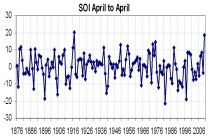
5960 stories have been posted and 120,259 members listed. When we monitored origins of contact, we were getting hits from 25 different countries but especially, the US, UK, Australia, Canada, New Zealand and Europe.
Icecap is a one man band with one valued part time contributor. We run far short of the top climate science web site, Watts Up With That. Deservedly so. Anthony Watts and his team do an excellent job and many authors contribute meaningful content. The comments section, something I could not manage alone because unfortunately it requires full time moderation makes a huge difference. Only Anthony, Climate Audit and Judith Curry’s site really allow free commenting. Anthony has passed the 106 million mark this month.
Climate realist blogs and skeptics are accused by the clueless alarmists and their toadies of being lavishly supported by big oil and big government. I can assure you, we barely recover enough from small very much appreciated donations to cover the costs of maintaining the servers and internet to keep these sites going. We both have outside businesses that pay our personal bills and sometimes subsidize the sites. Gleickgate proved the hypocrisy of the left and the alarmist community. While ignoring climategate as a crime, they treated Gleick as a martyr for the cause and Heartland as a villain. They criticiize the Koch brothers who unlike so many leftist foundations give their money to many different and worthwhile causes. The $200,000 initially reported turned out to be $20,000 given not for climate but for health care. Only 1/4th of the Heartland’s small budget goes to climate and most was spent on international conferences to which scientists from both sides of the issue were invited.
Anthony Watts posted a story yesterday that sums up very well how I and other skeptics must feel at times.
UPDATE: 3/17/12 Thanks to everyone for all the support, kind words, and well wishes. Today I found myself taking another long nap, and I awoke feeling much better than yesterday. Stress is an insidious thing, and until it catches up with you, you don’t realize what impact it has. - Anthony
It has been an exhausting month since Fakegate hit the scene, and tonight when I came home from work, I crashed hard, taking a nap. I even missed dinner. My children tried to wake me up apparently to no avail. At the moment I feel like I have a hangover.
Behind the scenes, I’m dealing with a lot of things related to WUWT and the legal fight building with the Pacific Institute and Gleick, plus other things. Today for example I’m wrestling with starting the blog all over again on another platform because my wordpress.com free hosting keeps messing under the hood with the production code and they’d broken something yet again (some readers can’t comment any more thanks to a new security feature) just after we got the mess with adwords fixed last week. So yeah, I’m pretty toasted all in all at the moment. Then I read this comment from a reader on the DeSmog Blog headed back to obscurity thread.
=========
Ally E. says:
March 16, 2012 at 2:10 pm
I found WUWT barely a month before Fakegate happened. Prior to finding this site, I was a head-in-the-sand kind of person. I knew the whole fry-and-die alarmism was wrong, the claims were getting very stupid, as was the panic.
Getting fed up with ever increasing nonsense scare tactics, I pushed back from news outlets. I didn’t want to hear anymore. I also felt very alone. It was Ian Plimer’s “How to get expelled from school” that opened my eyes to the growing fight back to rational thinking. I bought the book (and there were only two left on the shelf, so I know it’s popular) and read it in a day.
Encouraged, I got online and found WUWT and others. I cannot express how wonderful it felt to learn that REAL scientists out there are practicing REAL science and presenting it properly.
Point is, for those years I had my head in the sand, I didn’t know just what a tangled mess this had all become. I didn’t know what a horrible world was developing right under our noses.
I come here every day. This is my home page. I love the science, I love the way it is presented and I love reading the comments and thoughts from so many very intelligent people. But I also devour any news on the political front. I crave and seek out every snippet of good news, and believe me, this is good news.
Anthony, I want to see these dastards go down. I came in at a most exciting time and I want to watch every step of the alarmists fall from grace. Thank you for providing the whole picture, the wide picture, science, politics and all.
=======
Thanks, Ally. That made my week.
Thanks Anthony and Ally, you illustrate why we both continue this effort. Anthony and to some degree Icecap have made a difference. Thank you all for your loyalty and support over the years.
This post I wrote years ago sums up why our job won’t be easy. It will take the cycle 24 cooling that should accelerate with both oceans cold to unequivocally falsify the AGW theory and depose the profiteers and polically driven phonies. The media has not reported on the 15 years of lack of warming (Trenberth’s travesty) and falling sea levels or lack of ocean warming.
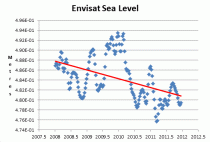
.jpg” title="Enlarged.">Enlarged.
Don’t expect them to go down easy. They will try and find reasons why man is responsible (e.g China’s burning of coal) and why their efforts and their gravy trains of grants should continue. Just this week we had Andrew Weaver arguing the record snows and cold in Alaska and four straight banner year for skiing at Whistler was due to global warming and Jeff Masters who named his company after Ayers and Dorn’s radical weather underground, who last few years claimed the cold and snow was due to diminished arctic ice and colder winter might continue, was arguing in this warm winter and recent record warm March temperatures that this was not the same climate of his father. Masters of course is wrong on both counts. His father likely grew up in the crazy decades of the 1940s to 1970s when cold, snow, heat and drought, floods, tornadoes and hurricanes were always in the news. Cold PDO, warm AMO and in the 1960s and 1970s reduced solar drives those extremes. We are exactly in the climate of his father and my father (whose years extended back through the dust bowl and heat and cold extremes of the 1930s) and could become like the years that Charles Dickens wrote about in the early 1800s if the solar cycles head like many solar scientists feel.
By the way the strong warm push north into Canada is the counter of the strong cold push south in the west all the way into Mexico. This is how weather normally works. Usually when the cold is pushing well south in the east, they sunning on the beaches and surfing in the water of California.
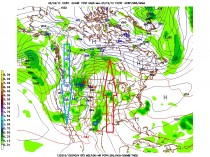
Enlarged.
by Simon, Australian Climate Madness

Yep, climate change
Following hot on the heels of the BoM/CSIRO climate report yesterday, today we have yet more scaremongering and alarmism.
David Karoly, Matthew England and Will Steffen are probably Australia’s three most hysterical climate alarmists. They have all featured regularly in these pages, and Will Steffen is one of the Labor government’s climate advisers.
And as we all know, any weather event, floods, drought, more cyclones, fewer cyclones, excessive heat, excessive cold, you name it, can be attributed to climate change. As has been said so many times, it is an unfalsifiable hypothesis - no event can disprove it - and therefore falls into the realm of pseudoscience. Bummer.
So when confronted with real world events which contradict their previous predictions, instead of admitting that there might be more to learn about the effects of climate on our weather, our three alarmists dig their heels in even further and make yet more extreme claims.
Put all those factors together, and you get this:
THREE of the nation’s leading climate scientists have linked the past two years of record wet weather to climate change in their strongest findings yet on the impact of global warming on the nation’s climate.
Professors Will Steffen, Matthew England and David Karoly, in a paper to be released today by the Climate Commission, find global warming may have contributed to the strength of the La Nina event and the heavy rainfall and flooding.
They also contend that the heavy rains do not contradict the trend towards drier weather for southern and eastern areas of Australia and find that despite two years of above average rains, southeast Australia continues to suffer from a cumulative rainfall deficit.
They reiterate warnings that global warming will produce longer dry spells, punctuated by heavier rainfall events, in southern and southwest Australia.
The release of the paper comes as Climate Commission chairman Tim Flannery faces increasing ridicule over his earlier predictions of water shortages in major capital cities due to drier weather resulting from global warming. (source)
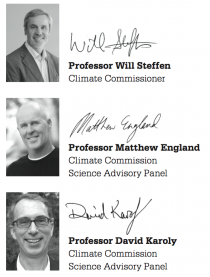
Top three alarmists
And from the report itself, right on cue comes the now hackneyed “consistent with” excuse:
The wetter conditions experienced in southeastern Australia in the last two years are consistent with scientists’ knowledge and understanding of how the climate is changing in the long term.
Because everything and anything is “consistent with” climate change, right boys? Here’s a challenge for our three heroes: what weather event would not be “consistent with” climate change? Answers on a postcard.
If you were a truly impartial scientist you would say, we don’t actually know how any changes in our climate will affect us, but these kind of events really help our understanding. Not spout yet more of the kind of alarmist nonsense that those three are all too famous for.
But that’s what happens when you are driven by an agenda - to prop up “The Cause” at all costs.
Don’t forget, the Climate Commission was set up by a government that has swallowed the IPCC line and wishes to enact a carbon tax, based on the threat of dangerous global warming… it would be highly inconvenient if dangerous global warming really wasn’t happening…
The full PDF report is here.
UPDATE: Daily Kos: Michael Mann is a Modern Hero and we need to acknowledge that! Vote in poll
Here is the encouraging news on the poll results this evening. Even Daily Kos readers think he is a fraud it appears.
---------------
By Joseph D’Aleo, CCM
In the markets, technical traders look to see if prices stay above or below key trendlines to determine if the trends are in tact.
The Rutger’s snow lab winter average is in and down as expected from last two years but stil is above the “‘trendline”. it is the 5th highest in 26 years and 14 highest in 35 years. Remember 4 of the 5 greatest snow years have occured in the last decade. 1977/78 was #1, 2009/10 #2, 2010/11 #3. 2007/08 #4 and 2002/03 #5. Three El Ninos and 2 La Ninas. All had negative AO/NAO.
See the extensive coverage across Canada and Asia.
See how except in the mountains of the west and northern parts of the northeast, snow is mainly absent in the lower 48 9or in Obama land the lower 55).
Despite the snow drought here in the US, in southern Alaska, snowfall has been amazing. In the snow season since July 1, in Valdez, 426 inches has fallen compared to a normal 276.1 inches. that is 149.9 inches ABOVE NORMAL and compares to 176.9 inches last year when the lower 48 was hard hit. Nearby Anchorage has had nearly double their normal snowfall so far.
Despite the early spring in the US, the hemispheric snowpack is well above the average. The below average period from Mid December to early January prevented us from ranking among the top again.
In other parts of the world like Italy, their winter resembled our in the US cities in recent years. This is from Italy.
Winter came in bursts in the lower 48. There was the Halloween snowstorm in the northeast. the january snowstorm in the Pacific Northwest and today another:
Historic March Snowstorms Along Oregon Coastline and in the Cascades
Steve Pierce, President, Oregon Chapter of the American Meteorological Society
Vancouver, Washington (March 13th 2012) - “Many residents along the coastline of Oregon awoke Tuesday morning to no power, downed trees, closed roads and as much as 8” of snow in a rare one-two punch. This storm will likely go down in the record books as one of the largest coastal snowstorms in the month of March ever recorded at some locations. Records date back to the late 1800’s along the Oregon coast. The last coastal snowstorm of this size in the month of March was in 1951 when between 4” and 8” inches of snow fell. What is even more rare about this storm is the fact that within 12 hours bewildered coastal residents went from 50 degrees with hurricane force wind gusts to 32 degrees and 6” of snow. All of this taking place just a week before the official start of spring.”
“A strong Pacific storm raced ashore Monday morning bringing wind gusts to nearly 90 mph along the Oregon coast line. By sunset Monday, near record setting snows were falling along nearly the entire coastline of Oregon including the the shoreline beaches. Areas that were hit especially hard included Pacific City, Tillamook, Lincoln City, Newport and Florence, Oregon. This area spans about 100 miles. Hwy 101 near Cape Foulweather (just north of Newport, OR) was closed in both directions due to downed trees and stranded cars as snow fell on freshly fallen timber overnight. Here is a look at the snow totals as of Tuesday morning.” Special thanks to the Portland office of the National Weather Service for this information ---
OREGON COAST
TILLAMOOK, OR = 8.5”
NEWPORT, OR = 6.0”
FLORENCE, OR = 5.0”
WILLAMETTE VALLEY
LIVINGSTON MTN - CAMAS, WA = 5.5”
HAPPY VALLEY, OR = 5.0”
BORING, OR = 4.0”
CANBY, OR = 2.5”
LONGVIEW, WA = 2.0”
CAMAS, WA = 2.0”
WASHOUGAL, WA = 2.0”
MILWAUKIE, OR = 1.2”
WILSONVILLE, OR = 1.1”
SALEM, OR = 1.0”
GRESHAM, OR = 1.0”
CASCADE MOUNTAINS
JUNE LAKE, WA = 21.0”
SPENCER MEADOWS, WA = 19.0”
SHEEP CANYON, WA = 17.0”
SURPRISE LAKES, WA = 15.0”
BENNETT PASS, MT HOOD, OR = 9.0”
MT HOOD MEADOWS, OR = 7.0”
GOVERNMENT CAMP, OR = 7.0”
TIMBERLINE LODGE, OR = 6.0”
MCKENZIE, OR = 6.0”
ROARING RIVER, OR = 6.0”
WILLAMETTE PASS, OR = 6.0”
TOMBSTONE, OR. = 3.0”
And as of Friday, March 16, 2012, Mark Albright reported:
It has been a week to remember in the North Cascades for those who like snow. In the past week ending 11 AM today (16 March 2012) Mt Baker (BAK42) has reported measurable precipitation on 160 out of a possible 168 hours totaling 10.2 inches of water equivalent precipitation while the snow pack has increased 65 inches from 193 to 258 inches. The snow pack now stands at about 155% of normal (164 inches) for 15 March. The ski area is reporting 308 inches (nearly 26 feet!) on top at an elevation near 5000 ft.
Quote from a skier after spending yesterday at Mt Baker:
“so deeep so sick ridiculous”
I wonder if Marys Peak above Corvallis will be bare of snow by April 1 this year? At noon today it is 31 degrees up on top of Marys Peak, but I don’t know how much snow there is. If you remember, the global warming experts (Phil Mote) at OSU have proclaimed that snow on Marys Peak on 1 April has become a rare event. In spite of that proclamation, last year Marys Peak still had snow on 1 July 2011, some 3 months after 1 April.
-mark albright
Update: See Monckton dismantle college environmentalists and professors at Union College in NYS covered by Anthony here and in video below.
See in this story how the liberal environmental professors afterwards met hurriedly with their brainwashed and shattered students afterwards to try and reclaim their credibility. That’s how the Nazi’s did it.
Also see the aurora from Lapland in this extended video.
Powerful Aurora borealis over Abisko National Park. 03-12-2012 from Lights Over Lapland on Vimeo.
----------------
By Anthony Watts, Watts Up With That
In June 1986, Dr. James Hansen made a prediction to a newspaper reporter in Oxnard, CA of a 2 degree temperature rise by 2006. This was two years before, almost to the day before he and Senator Tim Wirth duped a bunch of Washington legislators with stagecraft on a hot June day by turning off the a/c in the hearing room while complaining about global warming and urging the need for “immediate action” (translation: cash).
Like Dr. Hansen’s 20 year sea level prediction, it hasn’t come true. In honor of the 80s, when a popular TV commercial for a fast food restaurant had inspired a whole nation to say the catch phrase, I ask Dr. James Hansen, regarding your claims of global warming, “Where’s the Beef”?!
Let’s have a look at Exhibit A: Hansens’ GISTEMP graph, distributed worldwide from the GISS headquarters above Jerry Seinfeld’s favorite Monk’s Restaurant in New York City. Annotations in blue mine.
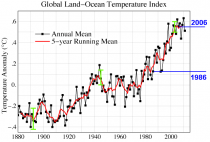
Source.
Exhibit B: The GISS Data, available here. Let’s do the math.
Global Land-Ocean Temperature Index (C)
(Anomaly with Base: 1951-1980)
----------------------------------
Year Annual_Mean 5-year_Mean
----------------------------------
1986 0.13 0.18
1987 0.28 0.20
1988 0.33 0.26
1989 0.21 0.31
1990 0.36 0.28
1991 0.35 0.24
1992 0.13 0.24
1993 0.14 0.25
1994 0.24 0.24
1995 0.39 0.30
1996 0.30 0.39
1997 0.41 0.40
1998 0.58 0.40
1999 0.33 0.43
2000 0.35 0.46
2001 0.48 0.46
2002 0.56 0.49
2003 0.55 0.54
2004 0.48 0.55
2005 0.62 0.56
2006 0.55 0.53
Finding the difference: 0.55C – 0.13C = 0.42C
Predicted change 2.0C compared to Actual change 0.42C = Climate Fail
Exhibit C: Where’s the Beef?!
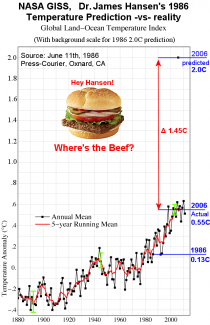
Note: I realize that I could have placed the top prediction at 2.13C, but why pile on? ![]() What’s 0.13C between friends? Besides he said “nearly” and it is near well enough.
What’s 0.13C between friends? Besides he said “nearly” and it is near well enough.
Don’t believe me? Read for yourself. The Press-Courier - Google News Archive Search
Big h/t to Steve Goddard at Real-Science for finding this one.
UPDATE: Some commenters suggested Hansen may have given the 2 degree number in Fahrenheit rather than Celsius. Another article on the same day suggests he did.
So at 4F we have 2.2 C If the reporter in the first story took the middle between 2-4F as 3F we have 1.67C or “nearly 2 degrees higher in 20 years” as the reporter from Oxnard states.
The 2010 Annual Mean Temperature anomaly from GISS is 0.63 C
So, no matter how you look at it, Hansen’s 1986 prediction has not come true.
Dr Craig Loehle on Watts Up With That
Many government reports by NASA, NOAA, EPA, USFWS, USFS, USDA and other agencies mention that climate change impacts are already observable in the USA. This is discussed in the context of endangered species conservation, forest resource assessment, future water availability, disaster planning, agriculture policy, etc. I have read many of these reports, which often refer back to the IPCC or the US Global Change Research Program. But they are usually vague on details of what bad things are expected to happen, generally referring to increases in extreme events. Nevertheless, these vague bad things are being used to guide policy.
The USA has some of the best data and is a large country. Are bad effects of climate change really visible already? In what follows, I address the evidence often put forward to support these claims and compare these to the literature. The true story is far from alarming.
Ocean Acidification
One government draft report indicated that ocean pH has increased (become more acid) by 0.1 units, and that this represents a 30% increase in acidity since 1750. Because pH is a log scale, estimating percent increases in acidity is problematic and a change of 0.1 units could not represent a 30% change in acidity as stated. A serious issue not addressed by the report is that a global time series of pH data for the oceans does not exist. Thus, the provenance of the 0.1 unit change in value is dubious, and the confidence intervals on such an estimate would no doubt be large. Furthermore, daily, seasonal, and between year pH fluctuations at any given location are on the order of ±0.3 pH units or more (Middelboe and Hansen 2007; Pelejero et al. 2005).
Sea Level Rise
Some reports state that sea level rise poses a threat to United States natural habitats, with other reports focusing on risks to developed areas. According to the Intergovernmental Panel on Climate Change (IPCC) temperatures due to human activity began to rise after 1980, but estimates of sea level show a rise from about 1870 (earliest records) at a nearly linear rate and with no sign of acceleration. Sea level rise from 1870 to 1980 is not likely due to human activity. One report indicates that IPCC has projected a sea level rise of 0.4 to 2 m by 2090, but the fourth IPCC report does not make such a claim, instead giving a best estimate of 0.28 to 0.43 m. Recent levels of rise (http://sealevel.colorado.edu), at 3.1 mm/year long-term trend or 0.31 m in 100 years with no indication of “acceleration,” are only consistent with the lowest IPCC projections. In fact, recent deceleration of the rate of rise (Houston and Dean 2011) has been detected. Examples of papers that projected sea level increases lower than the range discussed in the fourth IPCC report are Bouwer (2011), Chu et al. (2010), Czymzik et al. (2010), and Xie et al. (2010).
Temperature Increases
Government assessment reports note that US temperatures have risen 2F since 1961. However, conclusions about the extent of temperature increase depend heavily upon the start date for the calculation. Perhaps by coincidence, a start date of 1961 gives the most alarming rise. In contrast, there is almost no rise from 1938 to 2011 in the US. The same is true for sea surface temperature changes. This is because natural climate oscillations (e.g., Wyatt et al. 2011) produced a warm period in the mid-twentieth century with a cool period in the 1960s.
Floods
Reports assert that floods are increasing, but data do not bear this out. Hirsh and Ryberg (2011) showed that there is no trend toward increasing flood magnitudes in any region of the US, and a small decrease in the Southwest. Arrigoni et al. (2010) showed that climate change in the northern Rocky Mountains over 59 years has not significantly affected basin flows, although human habitat modifications have reduced the difference between minimum and maximum flows. Kundezewicz et al. (2005), in a global analysis of 195 long series of daily flow records, rejected the hypothesis of a growth in maximum daily flows. Increasing trends in flood damage can be fully accounted for by rising population and wealth.
Regional Drought Frequency
According to assessment reports, regional droughts are increasing in frequency and severity. However, they typically do not support this contention with any reliable data. Droughts are difficult to characterize and methods for doing so have become more sophisticated over time. The actual quantification of the “area” of a drought is also extremely subjective and no standard methods exist, nor do long-term standardized data.
Data related to precipitation and drought activity do not appear to support the contention of increasing drought frequency and severity and suggest that drought patterns are complex. For example, there has been a 5% increase in overall precipitation in the US rather than increasing drought. Sheffield et al. (2009) found that large-scale droughts follow ENSO and northern Pacific and Atlantic SSTs. This relation to ENSO activity is confirmed in a study in the US Southwest (McCabe et al. 2010). Globally, the mid 1950s had the highest drought activity and the mid 1970s to mid 1980s had the lowest, rather than a simple increasing trend. Again, picking the mid-1970s as a start date will give a false appearance of an increasing trend.
Extreme Storm Events
Assessment reports allege that extreme storm events are increasing even though storm severity per se is not reported or documented in any government archives. A “storm” is not even a well-defined object in climatology. There is an apparent increase in the number of tornados over time. However, improvements in radar quality and coverage over the past decades cause a detection bias trend, with more, smaller tornados being detected and recorded over time. Furthermore, increases in available disaster assistance aid have encouraged more frequent reporting of smaller storms in efforts to get disaster aid. Counting only category F4 and F5 events, which are relatively consistently detectable and recorded, there is no trend over the past 100 years (Balling and Cerveny 2003).
Hurricanes
Hurricane strength is said to be increasing. This can likely be attributed to increasing satellite coverage and resolution, which tends over time to more accurately capture the hours when a storm is at maximum strength. A study that corrects for storm detection ability over time (Vecchi and Knutson 2011) finds no trend in Atlantic hurricanes over the period of 1878 to 2008. Studies of landfall hurricanes (Balling and Cerveny 2003) also show no trend. The last landfall hurricane to hit (i.e., with the hurricane eye) the continental US was Katrina in 2005.
Fires
Reports suggest that warmer temperatures and changing precipitation patterns will cause more fires and affect the seasonality of fires. Indians and early European settlers both used fire extensively. Areas converted to agriculture (e.g., the Great Plains) now see almost no fire. Some western forests have higher fuel loads than 200 years ago. In the context of these and other large landscape changes, no one has documented a change in fire regimes in the US that can be attributed to climate change. In fact, the largest historical fires were in the West around 100 years ago. Human activities (changes in fuel loads, increased ignition sources, arson) have on the other hand been clearly documented effects on fire extent, as have “let burn” policies in the West, which have only been implemented in the past few decades..
Algal Blooms
Reports indicate that harmful algal blooms in aquatic ecosystems have become more frequent, intense, and widespread. Climate change is only one factor potentially causing harmful algal blooms, with increasing nutrient runoff a clearly important factor. There is no basis for ascribing trends in blooms to climate change. There is also an increasing ability to detect them as satellite imagery improves over time.
Changes in Ecosystems
There are studies showing responses to biota that are “consistent with” warming, but most of these are actually positive, whereas negative effects are hypothetical (e.g., phenology “might” be disrupted). For example, changes in bird migration and nesting dates indicate adaptation to changes rather than an alarming situation. The clearest data pertain to long-term trends in plant growth. These studies, with a few local exceptions, show regional to global net primary productivity (NPP) to have been increasing in the past 50 to 100 years (Alcaraz-Segura et al. 2010; Bellassen et al. 2011; Jia et al. 2009; Kohler et al. 2010; Lin et al. 2010; Nemani et al. 2003; Tian et al. 2010) due to both rising CO2 levels and increasing temperatures. If warming since the Little Ice Age is leading to increased NPP, this is difficult to construe as problematic.
Conclusions
Within the United States, the claim that bad climate effects can “already” be detected is a totally subjective and unsupported hypothetical.
Literature Cited
Aitken, S.N., Yeaman, S., Holliday, J.A., Wang, T., and Curtis-McLane, S. 2008. Adaptation, migration or extirpation: climate change outcomes for tree populations. Evolutionary Applications 1:95 111.
Alcaraz-Segura, D., Chuvieco, E., Epstein, H.E., Kasischke, E.S., and Trishchenko, A. 2010. Debating the greening vs. browning of the North American boreal forest: differences between the satellite datasets. Global Change Biology 16:760 770.
Anagnostopoulos, G.G., Koutsoyiannis, D., Christofides, A., Efstradiadis, A., and Mamassis, N. 2010. A comparison of local and aggregated climate model outputs with observed data. Hydrological Sciences Journal 55:1094 1110.
Arrigoni, A.S., Greenwood, M.C., and Moore, J.N. 2010. Relative impact of anthropogenic modifications versus climate change on the natural flow regimes of rivers in the northern Rocky Mountains, United States. Water Resources Research 46:W12542; doi:10.1029/2010WRO09162.
Balling, R.C., and Cerveny, R.S. 2003. Compilation and discussion of trends in severe storms in the United States: Popular perception v. climate reality. Natural Hazards 29(2):103 112.
Bellassen, V., Viovy, N., Luyssaert, S., LeMarie, G., Schelhaas, M.-J., and Ciais, P. 2011. Reconstruction and attribution of the carbon sink of European forests between 1950 and 2000. Global Change Biology 17:3274 3292.
Bouwer, L.M. 2011. Have disaster losses increased due to anthropogenic climate change? Bulletin of the American Meteorological Society 92:39 46.
Chu, P.-S., Chen, Y.R., and Schroeder, T.A. 2010. Changes in precipitation extremes in the Hawaiian islands in a warming climate. Journal of Climate 23:4881 4900.
Cole, K. 1985. Past rates of change, species richness and a model of vegetational inertia in the Grand Canyon, Arizona. American Naturalist 125:289 303.
Cole, K.L. 2009. Vegetation response to early Holocene warming as an analog for current and future changes. Conservation Biology 24:29 37.
Cwynar, L.C., and Spear, R.W. 1991. Reversion of forest to tundra in the central Yukon. Ecology 72:202 212.
Czymzik, M., Dulski, P., Plessen, B., von Grafenstein, U., Naumann, R., and Brauer, A. 2010. A 50 year record of spring‐summer flood layers in annually laminated sediments from Lake Ammersee (southern Germany). Water Resources Research 46:W11528; doi:10.1029/2009WR008360.
Hirsch, R.M., and Ryberg, K.R. 2011. Has the magnitude of floods across the USA changed with global CO2 levels? Hydrological Sciences Journal doi:10.1080/02626667.2011.621895.
Houston, J.R., and Dean, R.G. 2011. Sea-level acceleration based on U.S. tide gauges and extensions of previous global-gauge analyses. Journal of Coastal Research doi:10.2112/JCOASTRES D 10 00157.1.
Jia, G.J., Epstein, H.E., and Walker, D.A. 2009. Vegetation greening in the Canadian arctic related to decadal warming. Journal of Environmental Monitoring 11:2231 2238.
Kohler, I.H., Poulton, P.R., Auerswald, K., and Schnyder, H. 2010. Intrinsic water-use efficiency of temperate seminatural grassland has increased since 1857: An analysis of carbon isotope discrimination of herbage from the Park Grass Experiment. Global Change Biology 16:1531 1541.
Kundzewicz, Z.W., Graczyk, D., Maurer, T., Pinskwar, I., Radziejewski, M., Svensson, C., and Szwed, M. 2005. Trend detection in river flow series: 1. Annual maximum flow. Hydrological Sciences Journal 50(5):797 810.
Lin, D., Xia, J., and Wan, S. 2010. Climate warming and biomass accumulation of terrestrial plants: A meta-analysis. New Phytologist 188:187 198.
Loehel, C. 1998. Height growth rate tradeoffs determine northern and southern range limits for trees. Journal of Biogeography 25:735 742.
Loehle, C. 2000. Forest ecotone response to climate change: sensitivity to temperature response functional forms. Canadian Journal of Forest Research 30:1632 1645.
Loehle, C. 2003. Competitive displacement of trees in response to climate change or introduction of exotics. Environmental Management 32:106 115.
Loehle, C. 2011. Criteria for assessing climate change impacts on ecosystems. Ecology and Evolution doi:10.1002/ece3.7.
Loehle, C., and LeBlanc, D.C. 1996. Model-based assessments of climate change effects on forests: a critical review. Ecological Modelling 90:1 31.
Masek, J.G. 2001. Stability of boreal forest stands during recent climate change: Evidence from Landsat satellite imagery. Journal of Biogeography 28:967 976.
McCabe, G.J., Legates, D.R., and Lins, H.F. 2010. Variability and trends in dry day frequency and dry event length in the southwestern United States. Journal of Geophysical Research 115:D07108; doi:10.1029/2009JD012866.
Middelboe, A.L. and Hansen, P.J. 2007. High pH in shallow-water macroalgal habitats. Marine Ecology Progress Series 338: 107-117
Morin, X., Lechowicz, M.J., Augspurger, C., O’Keefe, J., Viner, D., and Chuine, I. 2009. Leaf phenology in 22 North American tree species during the 21st century. Global Change Biology 15:961 975.
Nemani, R.R., Keeling, C.D., Hashimoto, H., Jolly, W.M., Piper, S.C., Tucker, C.J., Myneni, R.B., and Running, S.W. 2003. Climate-driven increases in global terrestrial net primary production from 1982 to 1999. Science 300:1560 1563.
Noble, I.R. 1993. A model of the responses of ecotones to climate change. Ecological Applications 3:396 403.
Payette, S. 2007. Contrasted dynamics of northern Labrador tree lines caused by climate change and migration lag. Ecology 88:770 780.
Pelejero, C., Calvo, E., McCulloch, M.T., Marshall, J.F., Gagan, M.K., Lough, J.M. and Opdyke, B.N. 2005. Preindustrial to modern interdecadal variability in coral reef pH. Science 309: 2204-2207
Schliep, E. M., Cooley, D., Sain, S.R., and Hoeting, J.A. 2010. A comparison study of extreme precipitation from six different regional climate models via spatial hierarchical modeling. Extremes 13:219 239.
Sheffield, J., Andreadis, K.M., Wood, E.F., and Lettenmaier, D.P. 2009. Global and continental drought in the second half of the twentieth century: Severity-area-duration analysis and temporal variability of large-scale events. Journal of Climate 22:1962 1981; doi:10.1175/2008JCLI2722.1.
Stephens, G. L., L’Ecuyer, T., Forbes, R., Gettlemen, A., Golaz, J.-C., Bodas-Salcedo, A., Suzuki, K., Gabriel, P., and Haynes, J. 2010. Dreary state of precipitation in global models. Journal of Geophysical Research 115:D24211.
Tian, H., Chen, G., Liu, M., Zhang, C., Sun, G., Lu, C., Xu, X., Ren, W., Pan, S. and Chappelka, A. 2010. Model estimates of net primary productivity, evapotranspiration, and water use efficiency in the terrestrial ecosystems of the southern United States during 1895-2007. Forest Ecology and Management 259:1311 1327.
Tinner, W., Bigler, C., Gedye, S., Gregory-Eaves, I., Jones, R.T., Kaltenrieder, P., Krähenbühl, U., and Hu, F.S. 2008. A 700-year paleoecological record of boreal ecosystem responses to climatic variation from Alaska. Ecology 89:729 743.
Vecchi, G.A. and Knutson, T.R. 2011. Estimating annual numbers of Atlantic hurricanes missing from the HURDAT database (1878-1965) using ship track density. Journal of Climate 24:1736 1746; doi:10.1175/2010JCLI3810.1.
Wertin, T.M., McGuire, M.A., and Teskey, R.O. 2010. The influence of elevated temperature, elevated atmospheric CO2 concentration and water stress on net photosynthesis of loblolly pine (Pinus taeda L.) at northern, central and southern sites in its native range. Global Change Biology 16:2089 2103.
Williams, J.W., Tarasov, P., Brewer, S., and Notaro, M. 2011. Late Quaternary variations in tree cover at the northern forest-tundra ecotone. Journal of Geophysical Research 116:G01017.
Woollings, T. 2010. Dynamical influences on European climate: An uncertain future. Philosophical Transactions of the Royal Society A 368:3733 3756.
Wyatt, M.G., Kravisov, S., and Tsonis, A.A. 2011. Atlantic Multidecadal Oscillation and Northern Hemisphere’s climate variability. Climate Dynamics doi:10.1007/s00382 011 1071 8.
Xie, B., Zhang, Q., and Wang, Y. 2010. Observed characteristics of hail size in four regions in China during 1980–2005. Journal of Climate 23:4973 4982.
By Larry Bell, Forbes reprinted with author permission
It seems we keep hearing that scientists who challenge claims that our planet is on fire fueled by fossil energy are lackeys of a heavily funded disinformation campaign underwritten by Big Oil, Big Coal, and other Big Spenders. Notable authority on this conspiracy, Internet pioneer, Academy Award Oscar winner and Nobel Peace Prize laureate Albert Arnold Gore warned about this last year in a Rolling Stone article: “Polluters and Ideologues are financing pseudoscientists whose job it is to manufacture doubt about what is true and false [and] ...spending hundreds of millions of dollars each year on misleading advertisements in the mass media.”
Given that the mercenary climate skeptic cadre appears to be awash in ill-gotten carbon footprint-stained gains, I am somewhat embarrassed to admit that such evil organizations have never seen fit to offer me gobs of money. After all, I frequently write articles arguing that there is no basis for climate alarm and critical of charities essential to support otherwise unsustainable “green” energy fantasies. Why should I, alone, miss out on those pay offs? Sure, I have repeatedly opposed subsidies for all other energy providers as well. Still, it just hasn’t seemed fair to be passed over with such harsh neglect.
Frankly, this didn’t really bother me all that much until I recently read that the Heartland Institute received “shocking” contributions from nefarious donors. This was revealed in confidential information illegally obtained and distributed by renowned “mainstream” climate scientist Peter Gleick who received a MacArthur Foundation “genius grant” and chaired the American Geophysical Union (AGU) Task force on Scientific Ethics. It seems he had a simultaneous lapse of both attributes. And by the way, that’s the same AGU that released a famous conclusion based on Ouija board survey methodology that 97% of all scientists believe that global warming is a serious, human-caused curse.
At first, it appeared that Heartland’s fossil industry-funded debauchery was much worse than many of us could have possibly imagined....an astounding gift of $25,000 from the Koch Foundation alone… over a short period of just ten years! Well okay, that money was actually earmarked for a health care newsletter rather than to advance their insidiously skeptical positions regarding a looming climate catastrophe. Nevertheless, that suspected salacious liaison was titillating enough to get some prominent press pundits panting.
If that wasn’t bad enough, another forensically and factually flawed document in the batch, which was falsely attributed to Heartland, put the contribution amount at $200,000. But then, why quibble over what amounts to little more than an innocently misplaced decimal point? And as warminista sensationalists apparently believe: numbers, schlumbers…what does it matter so long as you get the big message across?
Think rising oceans for example. In a December 6, 2005 presentation to the AGU, NASA Goddard Space Institute head and long-time Gore advisor James Hansen predicted that the Earth’s climate was reaching a human-caused tipping point that will cause sea levels to rise as much as 80 feet during this century. Not one to understate scary probabilities, this was more than 40 times higher than even the upper worst case end of what the most recent alarmist U.N. Intergovernmental Panel on Climate Change (IPCC) summary report has projected.
ICECAP ADDITION:

Enlarged. Last 4 years of global sea level - oh my Al and James you have soem ‘splaining to do’.
Absent any known basis for this, I’m unaware of any criticism of that remarkable assertion from the AGU or any other of those self-proclaimed mainstream climate organizations. Also, what about unsupportable claims regarding imperiled polar bears, a human CO2 -caused Himalayan glacier retreat, and increasing global warming-induced hurricane threats...to name only a few examples? Have you heard any vociferous rebuttals from established bastions of scientific authority?
Didn’t think so.
Maybe that’s because there’s no record that the sources received any money from ExxonMobil or their conspiratorial ilk. No, it all came from us through tax money we generously provided to “get the truth”.
Perhaps you can imagine my relief to learn that Heartland didn’t get any ExxonMobil money after all...that I wasn’t the only one they overlooked. In fact it turned out that most of Heartland’s budget was provided by innocuous and rather boring private donations and grant sources. You gotta admit that it’s pretty chintzy for Exxon not to give at least something to them...an organization that according to the Associated Press is “one of the loudest voices denying human-caused global warming, hosting the largest international scientific conferences on climate change.”
Wouldn’t you expect Exxon and other fossil confederates to be at least a little charitable to a not-for-profit entity that has been dubbed “the ideological center of the denial movement”? Geeze, they sure are providing a great deal of bang for the buck in what ...as Al claims to be...manufacturing a lot of doubt about what is true and what is false.
Consider that about one-quarter of their total $4.4 million 2011 budget that Heartland devoted to climate research dissemination activities is barely a rounding error in what other opposing-view non-profits spend. For example, compare this with Al Gore’s Alliance for Climate Protection which reportedly netted more than $88 million in 2008, the Natural Resources Defense Council, which reportedly took in more than $95 million in 2011 operating revenues, and the World Wildlife Fund that raised more than $238 million last year.
Then there’s also many other international philanthropic organizations that copiously support climate-frenzy causes. Consider, for example, the European Climate Foundation (ECF) which “aims to promote climate and energy policies that greatly reduce Europe’s greenhouse gas emissions and help Europe play an even stronger international leadership role in mitigating climate change.” ECF partners include the William and Flora Hewlett Foundation, which awarded a $460,800,000 donation to another partner, the ClimateWorks Foundation in 2008…plus $100 million more to them this year. ClimateWorks presents itself as “a global family of affiliated organizations that support public policies that prevent climate change and catalyze sustainable global prosperity.” ("Prevent climate change”? Understandably, that alone will really cost a bunch!)
Also, lest we forget, there’s a whole lot of other money available for those who will carry water for climate crisis and renewable energy promotion. The IPCC costs Western taxpayers about $6.5 million annually, and that’s but a drop in the bucket compared with the $2.6 billion the White House plans to spend on research into “the global changes that have resulted primarily from global over-dependence on fossil fuels.” (Is it just me, or does this possibly constitute a somewhat biased premise for science funding?)
That ain’t nearly all. Data compiled by Joanne Nova at the Science and Policy Institute indicates that the U.S. Government spent more than $32.5 billion in climate studies between 1989 and 2009. This doesn’t count about $79 billion more spent for climate change technology research, foreign aid and tax breaks for “green energy”.
According to the GAO, annual federal climate spending has increased from $4.6 billion in 2003 to $8.8 billion in 2010, amounting to $106.7 billion over that period. The money was spent in four general categories: technology to reduce greenhouse gas emissions, science to understand climate changes, international assistance for developing countries, and wildlife adaptation to respond to actual or expected changes. Technology spending, the largest category, grew from $2.56 billion to $5.5 billion over this period, increasingly advancing over others in total share.
OMB pointed out that their previously noted agency budget compilations didn’t include revenues lost for the special deductions and tax credits intended to encourage greenhouse gas emission reductions. They attributed those subsidies to costing $7.2 billion in federal revenue losses during 2010 alone, ($16.1 billion since 1993), bringing the total since 2003 to $122.8 billion. Then there’s also still another $26.1 billion earmarked for climate change programs and related activities within the 2009 American Recovery and Reinvestment Act (or “Stimulus Bill").
Climate change spending won’t slow any time soon...not so long as current Obama policies prevail. A proposed $1.328 billion FY 2012 budget presented last June for its Global Climate Change Initiative (GCCI) aimed at helping developing countries address man-made global warming problems we have allegedly caused represents a 557% increase since FY 2008 ($202 million). Implemented through programs sponsored by the Department of State, Treasury, and the U.S. Agency for International Development (USAID), it is funded by the administration’s executive budget.
As stated, “The President’s FY2012 budget request follows on the December 2010 United Nations Framework Convention on Climate Change (UNFCC) negotiations in Cancun, Mexico, which formulated a package of ‘nationally appropriate’ measures toward the goal of avoiding dangerous climate change.” This is part of “...a commitment to near-term and long-term climate financing for the least developed countries amounting to nearly $30 billion for the period 2010-2012, and $100 billion annually by 2020.”
So if climate crisis and “green energy” skeptics expect to make any money, we’ve obviously joined the wrong side of the funding divide. Yup, sadly, I’ve pretty much abandoned any expectations that the Koch brothers or Exxon are going to send me a gratitude check any time soon. Like a large number of others who share my concerns about America’s current scientifically unjustified, economically disastrous climate and energy policies, I guess I’ll just have to continue plugging along, tilting at windmills and warm-mongers, solely because it’s important to do so. That’s plenty of reason enough.
But, hey, just in case, my bank deposit account routing number is available upon request.
By Marlo Lewis, Global Warming.org
Donna Laframboise asks the key question about Fakegate: ”Where do Gleick Apologists Draw the Line?”
In a recent post on her Web site, No Frakking Consensus, she provides excerpts from scientists, ethicists, and activists who excuse or even lionize Peter Gleick for stealing Heartland Institute budget documents, impersonating a Heartland board member, misrepresenting himself to bloggers as an anonymous “Heartland insider,” and palming off as genuine - maybe also authoring - a fake climate strategy document in which Koch supposedly funds Heartland to keep opposing voices out of Forbes magazine, sell doubt as their product, and dissuade teachers from teaching science.
Laframboise comments: “Climate change is a strange beast. When it enters the room, even ethicists lose the ability to think straight.”
At the end of her post, she asks Gleick’s apologists what other unlawful actions they believe would be justified if necessary to advance their cause:
I get it. Lying and stealing and misleading are OK so long as they help advance a good cause. What else is acceptable? Old fashioned burglary? Arson? Car bombs?
Where is the line?
There is no moral equivalence between Gleick’s theft of Heartland’s budget documents and the release of Climate Research Unit (CRU) emails - quite possibly by a whistle blower - that triggered the Climategate scandal.
The CRU is a tax-funded organization; thus, its research and work-related emails are subject to freedom of information laws. Heartland is a privately-funded organization; thus, its planning documents are not subject to such laws. As we know from the Climategate emails, CRU scientists stonewalled FOIA requests for years to prevent independent researchers from checking their data and methods. That was a bona fide scandal, not only because evading FOIA is unlawful, but also because scientists who deny independent researchers the opportunity to reproduce (invalidate) their results attack the very heart of the scientific enterprise.
Leaking the CRU emails was the only way to (a) produce documents responsive to valid FOIA requests, (b) expose CRU’s willful evasion of FOIA, and (c) subject CRU research products to the indispensable scientific test of reproducibility. Gleick’s theft of the Heartland documents served no legal or scientific-integrity objective. The Heartland documents reveal no breach of professional ethics or law, which is why somebody (Gleick?) had to fabricate a ‘confidential climate strategy memo’ to make Heartland look bad.
Nonetheless, warmistas such as DeSmog Blog, which published the purloined Heartland documents, applaud Gleick as a whistle blower, and stubbornly insist the fake strategy memo is genuine, loudly denounced Climategate as the work of an “illegal hack” of emails “stolen” from the CRU server.
The Gleick affair thus brings into sharp focus what has been apparent for some time, namely, the warmist movement is imbued with a ‘one law for me, another for thee‘ mentality. Such a mindset is toxic to democracy and scientific integrity alike.
As DeSmog Blog sees the world, those who espouse Gorthodoxy have a moral right to (1) flout FOIA and the rules of scientific discourse, and (2) violate the legal rights of climate alarm skeptics. DeSmog and its allies fancy themselves cutting-edge defenders of “the science.’ In fact, their mentality is thoroughly medieval.
In Europe’s wars of religion, sectarians often tried to justify unconscienable behavior on the grounds that they had no ethical or legal obligation to “heretics” (i.e., anyone who believed differently than they did). John Locke excoriated this pious fraud in his Letter Concerning Toleration:
Another more secret evil, but more dangerous to the commonwealth, is when men arrogate to themselves, and to those of their own sect, some peculiar prerogative covered over with a specious show of deceitful words, but in effect opposite to the civil right of the community. For example: we cannot find any sect that teaches, expressly and openly, that men are not obliged to keep their promise; that princes may be dethroned by those that differ from them in religion; or that the dominion of all things belongs only to themselves. For these things, proposed thus nakedly and plainly, would soon draw on them the eye and hand of the magistrate and awaken all the care of the commonwealth to a watchfulness against the spreading of so dangerous an evil. But, nevertheless, we find those that say the same things in other words. What else do they mean who teach that faith is not to be kept with heretics? Their meaning, forsooth, is that the privilege of breaking faith belongs unto themselves; for they declare all that are not of their communion to be heretics, or at least may declare them so whensoever they think fit [emphasis added].
DeSmoggers adhere to a similar doctrine: No faith with skeptics. Those preaching “no faith with heretics” rejected the civil and religious equality essential to a free society. Locke urged magistrates not to tolerate anyone preaching such intolerance.
Thomas Jefferson improved on Locke, arguing that the best way to deal with intolerant sects is to let them discredit themselves in the marketplace of ideas. Jefferson’s Virginia Statute of Religious Freedom concludes by affirming:
. . .that it is time enough for the rightful purposes of civil government, for its officers to interfere when principles break out into overt acts against peace and good order; that truth is great and will prevail if left to herself, that she is the proper and sufficient antagonist to error, and has nothing to fear from the conflict, unless by human interposition disarmed of her natural weapons, free argument and debate, errors ceasing to be dangerous when it is permitted freely to contradict them.
Gleick and his apologists have discredited themselves far more than any Heartland Institute climate science report, climate conference, or global warming curriculum could accomplish.
Fortunately, nothing I say here will make them wise up.
Craig Rucker
Legal challenges by states and industry groups over the Environmental Protection Agency’s efforts to regulate carbon dioxide and other greenhouse gases could and should be decided in the challengers’ favor. Whether that will happen in this highly politicized, semi-scientific matter of “dangerous manmade global warming and climate change” remains to be seen. Regardless of what the DC Court of Appeals decides, the case will almost assuredly return to the Supreme Court, where the outcome is equally uncertain.
In Massachusetts v. EPA, the Supreme Court said EPA had the authority (but not the obligation) to regulate CO2 under the Clean Air Act’s “capacious definition of air pollutant.” EPA could do so, the court ruled, if its administrator concluded that GHG emissions “may reasonably be anticipated to endanger public health or welfare.” In other words, the administrators opinion was not sufficient. The agency must conduct a scientific study and make a convincing scientific case for taking action.
Not surprisingly, Administrator Lisa Jackson decided that CO2 does endanger public health and welfare, and signaled her intention to regulate these emissions. However, there are serious problems with this.
First, EPA conducted no original research of its own. Relying on work by the Intergovernmental Panel on Climate Change and other agencies, it merely selected existing studies and reports that supported its predetermined outcome - and ignored numerous studies that contradicted its decision.
Second, scientific opinion is sharply divided on the extent to which these gases might contribute to climate change. EPA chose to disregard this inconvenient truth – and continue the shoddy practice begun by the IPCC and alarmist climate scientists of refusing to discuss or debate the validity of computer models, assertions of imminent disaster, and evidence for and against the catastrophic AGW hypothesis.
Third, carbon dioxide simply is not a “pollutant” within the meaning of the Clean Air act. It is not an agent that fouls or contaminates the air, making it harmful to human health. In fact, CO2 is a natural component of Earth’s atmosphere and a key ingredient in photosynthesis. Without carbon dioxide all life on Earth would cease to exist.
Fourth, both the 2007 Supreme Court decision and the IPCC studies relied on by EPA predate the Climategate emails and other scandals that have revealed how contrived, questionable and perhaps even fraudulent global warming disaster “science” actually is. Had those documents surfaced prior to its 2007 deliberations, the Court’s decision might well have been very different.
Fifth, allowing EPA to impose its CO2/GHG regulatory regime would effectively put the agency in charge of every aspect of Americans’ energy use, economic activities and lives. EPA’s unprecedented and exorbitantly expensive rules will severely and adversely affect hydrocarbon use, energy prices, food production, manufacturing, transportation, jobs, home and office heating and cooling, hospital and school operations - and thus human health and welfare.
Finally, and most absurd of all, even eliminating every source of carbon dioxide in the USA - electricity generation, vehicles, industries, humans and animals - would do nothing to reduce other emission sources worldwide. While US carbon dioxide emissions are declining, those sources continue to raise atmospheric CO2 concentrations. Thus, despite their devastating impacts on America’s economy and living standards, EPA’s rules would do virtually nothing to forestall the harms that its pseudo-science predicts.
Into this legal, scientific and regulatory cesspool now comes yet another element, which may yet go down as a key turning point in the debate - more important even than Climategate: Peter Gleick’s February 14 transmission of several stolen documents and a forged memorandum to 15 environmental activists in the United States and possibly abroad.
The stolen documents were taken from The Heartland Institute, a Chicago-based think tank that has received increasing attention for challenging IPCC and EPA global warming doom and gloom dogma, misinformation and propaganda. (Among the documents stolen were lists of HI donors and its entire 2012 budget.) The left and its mainstream media lapdogs had a field day with the information, but focused almost exclusively on the forged memo, which purported to reveal Heartland’s secret “climate strategy” - to make school children, citizens and legislators better informed about actual climate science.
Six days later Gleick, president and co-founder of the Pacific Institute, confessed to the crime. Virtually everyone now agrees the memo is a poor forgery, probably written by Gleick, although he still denies having done so.
Gleick is a prominent member of the global warming clique. His take-down is big news, and one reason this scandal could overshadow Climategate in its impact on global warming debates. Despite all the Sturm und Drang caused by Climategate, no one really paid a price for the gross misbehavior revealed by the leaked emails - even though the actions were funded with taxpayer money and used to promote bogus science, harmful public policies, and massive changes in energy use and living standards.
Gleick has been forced to step down from several positions, including as president of the Pacific Institute, and will likely face civil and criminal charges. His is likely to be only the first scalp that global warming “realists” collect from this incident. Heartland has indicated it will also go after Gleick’s accomplices in major environmental organizations and even in the drive-by media.
The criminal and civil cases will drag out for years, and discovery could uncover even more misbehavior in the alarmist camp than did Climategate. Heartland may also face discovery, but the stolen documents suggest that it has little or nothing to hide.
Why did Gleick target Heartland? As HI president Joseph Bast wrote to climate scientist Judith Curry in a message posted on her blog, Climate Etc: “I suspect he targeted us because we have done so much to document and rebut the assumptions and exaggerations of the global warming alarmists.” He then mentioned Heartland’s monthly publication, Environment & Climate News, its persuasive multi-volume response to the IPCC, Climate Change Reconsidered, and its six international climate conferences. (See http://judithcurry.com/2012/02/24/why-target-heartland)
Climategate caught the global warming establishment off-guard, but it soon regained its footing, aided immensely by the billions of dollars that governments are pouring into the “climate crisis” industry. Fakegate is rocking their world again, revealing the alarmists’ increasing desperation that the debate they don’t want to have will cost them their credibility, prestige, power and funding. This time, Fakegate may sweep some of them off their feet.
Who knew what Gleick was up to, and when did they know it? Who was Gleick trying to impress by this theft and forgery, and what did he and his accomplices seek to gain?
In the digital era, every email and every PDF document leaves a digital trail. There will be no cover up this time, no white-wash investigations by friendly IPCC and university colleagues. The perpetrator can’t take the Fifth Amendment in a civil suit, and the prospect of time in jail has been known to loosen lips. The whole global warming cabal is wondering when the next shoe will drop, and drop it shall.
The truth will finally come out, and the world will be better for it.
_______
Craig Rucker is a co-founder of the Committee For A Constructive Tomorrow and serves as its executive director.
Dr Peter Gleick provides more evidence that the supporters of the Cause will stop at nothing.
By Christopher Booker
What a very odd situation we find ourselves in, due to the extraordinary transformation in recent years of the so-called debate over global warming. Last week, The Sunday Telegraph reported that, as part of Britain’s overseas aid budget, the Department for International Development is well on the way to spending 1.5 billion pounds on a mass of climate-related projects across the world. These range from helping Indian farmers to irrigate their fields with foot-powered pumps rather than diesel-fuelled ones, to preventing the authority of Kenyan “rainmakers” from being undermined by the onset of “extreme weather events”.
This is bizarre enough - and it might be added that, according to the World Resources Institute, Britain is now spending far more on this kind of nonsense, under the UN’s $28 billion Fast Start Climate Change programme, than any country in the world apart from Japan. But even this is only a tiny fraction of the hundreds of billions Britain is hoping to spend, as a consequence of our Government’s unique obsession with global warming, on everything from climate-related research in our universities to building the 32,000 useless windmills that Chris Huhne was babbling about, before he ignominiously left office. We cannot recall often enough that our Climate Change Act commits us to spending more than 700 billion pounds between now and 2050 - far more than any other country in the world.
Yet while successive British governments have plunged headlong into this madness, the “science” supposedly used to justify it has been falling apart in all directions. Global temperatures have signally failed to rise as the computer models, upon which the whole scare was based, said they should. And an endless succession of scandals has engulfed the senior scientists who did more than anyone else to promote the scare. These began with the exposure of the notorious “hockey stick” graph and then the Climategate emails which showed how they fiddled their data and stopped at nothing to discredit anyone who challenged what they called “the Cause”. The scandals continued with the revelations that much of the work of the UN’s Intergovernmental Panel on Climate Change - the supreme champion of the Cause ‘ had not been based on science at all but on scare stories dreamed up by environmental activists.
All this has left the debate over climate change in a depressingly fetid state, as supporters of the orthodoxy lash out with increasing desperation, forlornly trying to defend their crumbling faith. A further example of this was the strange little scandal that erupted last week, with the release on the internet of various documents from the Heartland Institute, a Chicago-based think-tank long vilified by the warmists for organising conferences attended by hundreds of distinguished scientists from across the world who dare to be sceptical of the orthodoxy.
The documents were entirely innocuous except for one, which stood out from the rest because it purported to be a secret “strategy paper” that outlined Heartland’s plans to get the teaching of the science of climate change outlawed in America’s schools. This seemingly damning revelation aroused much excitement among warmists on both sides of the Atlantic. The Guardian published no less than nine separate items about it.
Read more here.
---------------------
Is the fight against global warming alarmism hopeless?
February 26th, 2012 by Roy W. Spencer, Ph.D
NOTE: The following light-hearted and playful editorial was whipped up after seeing a new Washington Post editorial on their Post(-Normal) Opinions page entitled Is the fight against global warming hopeless? I took the text of that article (which I encourage you to read first) and added some creative modifications. Only a few of the sentences were left intact, which are their creations, not my own…although I doubt the WaPo editorial board will agree with the context I have used them in. Snicker.
Is the fight against global warming alarmism hopeless?
IS THE FIGHT against global warming alarmism hopeless? It can seem so. The long-term threat to humanity comes from fears that carbon dioxide, which is necessary for life on Earth to exist, will lead to damaging energy policies which kill perhaps millions of poor people around the world each year. Fortunately, after decades of effort, only about one-tenth of America’s energy mix comes from renewable sources that don’t produce life-enhancing carbon dioxide, and which are so expensive they reduce prosperity for all.
But two policies could allow inefficient, wealth-destroying carbon-free technologies to try to catch up to their less expensive competitors. One is aimed at greenhouse substances that clear out of the atmosphere after a few years, months or even days (as if the climate system really cares than much about them). Cutting back the emission of soot and ozone gases such as methane (sic) could reduce the world’s warming by an unmeasureable amount over the next few decades. Adding hydrofluorocarbons - another class of short-lived pollutants - to the list wouldn’t really help to delay the approach of temperature thresholds beyond which global warming could be catastrophic, since those thresholds are entirely in the realm of fanciful theories anyway.
Alarmists believe that reducing these emissions is relatively cheap, especially when the benefits to health are factored in - but at the exclusion of the dangers to health of the reduced prosperity which would also result. For example, primitive cooking stoves in developing countries produce much of the world’s soot; alarmists think using more efficient ones would prevent perhaps millions of deaths from respiratory illness, as if poverty can be alleviated by giving poor people a solar cooker.
Methane, meanwhile, is the primary component of natural gas - a commodity that pipeline or coal-mine operators could sell if they kept it from escaping into the atmosphere. Researchers have curiously concluded that global crop yields would rise...a speculative and even hypocritical claim considering the known benefits to photosynthesis of adding more CO2 to the atmosphere from fossil fuel burning.
Coordinating an effective international effort to cut funding to long-lived climate alarmism enforcers will be the hardest task. Science institutions worldwide have spoken out on the need to address global warming, despite no scientist really knowing how much of past warming (which ended ten years ago) is natural versus manmade, and despite those institutions knowing virtually nothing about the underlying science.
Climate alarmists will waste more than just American money. Regulators in the developing world push to enforce stronger air-pollution rules, which expands the role of government and provides job security for bureaucrats, while ignoring the downside of diverting too much of the taxpayers’ money away from other, more worthy goals.
Since many of the health benefits of fossil fuels have been taken for granted by people, politicians are too eager to cut carbon dioxide emissions, without realizing there are very good reasons that we use carbon-based fuels.
One development that promises to provide abundant energy without the meddling of environmental activists - America’s natural gas boom - faces a challenge of a very different sort: the environmentalists themselves. Innovative drilling techniques have made huge amounts of fuel deep below Americans’ feet retrievable at low cost. Most of it is methane, a greenhouse gas that produces only about half the carbon as coal after combustion. Environmentalists should be cheering: Cheap gas transported for the most part in existing pipelines can start the United States on a wealth-enhancing path with minimal added cost.
That path will be followed naturally, based upon market forces and the ever-present consumer demand for energy. This might well eventually steer us away from fossil fuels, if only because they will gradually be depleted and so their price will by necessity rise.
There is reason for hope - but not for complacency - over the coming years that the ill-conceived policy fantasies of climate alarmists can be fended off so that the poor of the world have a chance to prosper, with continuing access to our most abundant end least expensive energy sources - carbon-based fuels.
This editorial represents the views of Dr. Roy W. Spencer as a professional climate scientist and semi-professional economist wannabe, as determined through debate among the various voices in his head. See Roy’s post hhttp://www.drroyspencer.com/2012/02/is-the-fight-against-global-warming-alarmism-hopelessere.
Also see here why bringing sanity back to the billions without Roy’s sense and sensibilities (and sense of humor) hasn’t been easy here.
Marlo Lewis
The Heartland Institute plans to pay Indur Goklany, an expert on climate economics and policy, a monthly stipend to write a chapter on those topics for the Institute’s forthcoming mega-report, Climate Change Reconsidered 2012. Earlier this week, Greenpeace and Rep. Raúl Grijalva (D-Ariz.) called for a congressional investigation of Goklany. In addition to being an independent scholar, Goklany is a Department of Interior employee. Federal employees may not receive outside income for teaching, writing, or speaking related to their “official duties.”
But as I pointed out yesterday on this site, climate economics and policy are (to the best of my knowledge) not part of Goklany’s “official duties.” It would be shocking if they were. Goklany is a leading debunker of climate alarm and opposes coercive decarbonization schemes. Why on earth would the Obama Interior Department assign someone like that to work on climate policy?
Greenpeace and Grijalva have got the wrong target in their sites. The inquisition they propose might actually have some merit if directed at one of their heroes: Dr. James Hansen of NASA. Hansen has received upwards of $1.6 million in outside income. And it’s not unreasonable to assume that most or all of that income was for teaching, writing, and speaking on matters “related to” his “official duties.”
My colleague Chris Horner laid out the juicy details last November in a column posted on Watts Up With That. In “Dr. James Hansen’s growing financial scandal, now over a million dollars of outside income,” Chris argued that Hansen gets substantial outside income for activities related to his official duties and does not always comply with federal financial disclosure regulations:
NASA records released to resolve litigation filed by the American Tradition Institute reveal that Dr. James E. Hansen, an astronomer, received approximately $1.6 million in outside, direct cash income in the past five years for work related to - and, according to his benefactors, often expressly for - his public service as a global warming activist within NASA.
This does not include six-figure income over that period in travel expenses to fly around the world to receive money from outside interests. As specifically detailed below, Hansen failed to report tens of thousands of dollars in global travel provided to him by outside parties - including to London, Paris, Rome, Oslo, Tokyo, the Austrian Alps, Bilbao, California, Australia and elsewhere, often business or first-class and also often paying for his wife as well - to receive honoraria to speak about the topic of his taxpayer-funded employment, or get cash awards for his activism and even for his past testimony and other work for NASA.
Ethics laws require that such payments or gifts be reported on an SF278 public financial disclosure form. As detailed, below, Hansen nonetheless regularly refused to report this income.
Also, he seems to have inappropriately taken between $10,000 and $26,000 for speeches unlawfully promoting him as a NASA employee.
There’s more in Chris’s post, but you get the drift.
Now, I wondered whether Hansen, an employee of NASA, an independent agency, is subject to the same outside compensation rules as Goklany, an employee of an Executive Agency. The answer is yes. NASA’s guidelines on “outside employment” state that “Employees should refer generally to the Standards of Ethical Conduct for Employees of the Executive Branch, 5 CFR Part 2635,” and must comply with Subpart H.
CFR Part 2365, Subpart H bars an employee from receiving compensation for speaking, teaching, or writing “that relates to the employee’s official duties.” Quite sensibly, though, the employee may receive compensation for speaking, teaching, or writing not related to his official duties:
Note: Section 2635.807(a)(2)(i)(E) does not preclude an employee, other than a covered noncareer employee, from receiving compensation for teaching, speaking or writing on a subject within the employee’s discipline or inherent area of expertise based on his educational background or experience even though the teaching, speaking or writing deals generally with a subject within the agency’s areas of responsibility.
This language seems to fit Goklany to a tee. The proposed chapter for Heartland on climate economics and policy is within Goklany’s discipline and area of expertise but it is not related to his official duties.
Can anyone with a straight face say the same about Hansen? How could Hansen’s teaching, speaking, and writing about climate change not be related to his official duties? How then could the outside income he has received for those activities not be unlawful?
Rep. Grijalva’s demand for a House Resources Committee “hearing” on Goklany is preposterous. A letter of inquiry would suffice even if there were evidence of improper conduct, which there is not.
My unsolicited advice to Committee Chair Doc Hastings (R-Wash.) is to politely reject Grijalva’s request but also to ask Grijalva, just for the record, whether he and Greenpeace think the Committee should investigate James Hansen’s million dollar-plus outside income.
By Joseph D’Aleo, CCM
Rep Waxman, California’s embarrassing representative and equally clueless Bobby Rush of Illinois cited recent data released by the National Oceanic and Atmospheric Administration (NOAA) as the basis for their hearing request. During January, the average temperature in the United States - excluding Alaska where it was coldest ever and Hawaii - was 5.5 degrees above normal, according to NOAA. In a Wednesday letter addressed to GOP committee leaders, Waxman and Rush wrote that a hearing to discuss these findings would “provide members with a more robust understanding of the scientific consensus around rising temperatures.”
“Denial of basic science is a serious obstacle for action to understand and address global climate change,” Waxman and Rush wrote. “Yet last year during debate on H.R. 910, all Republican members of the Committee voted against a simple amendment that recognized that warming of the climate is occurring.”
No mention was made of the globe actually being the second coldest January since 1993 and no global annual change since at least 1997.
Or that over the last decade every region has declined.
Here’s a breakdown for CONUS by region for Winter through 2010/11. Click here to enlarge to full size to view the graphs.
Though it will rank among the warmest winters in the US, a brutally cold Alaska and positive NAO in La Nina means the dominance of pacific air in the lower 48 states and lower than normal snowfall. Snowfall makes a full 5 -10 F difference in temperatures. this is not unlike soil moisture’s effect in the warm months. The heat in Texas was accentuated by the lack of soil moisture this past summer, leading to record warmth.
By the way last winter was the third snowiest on record in the Northern Hemisphere behind just 1977/78 and 2009/10.
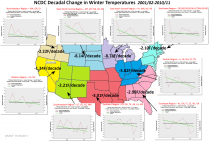
Enlarged.
Though snowfall this winter in the lower 48 states was below normal, it was well above in southern Alaska and the rest of the hemisphere.
Meanwhile, green politicos are scurrying to try and deflect attack on Gleick by attacking skeptics the stolen documents showed received some money to do reviews for Heartland’s sponsored NIPCC report. As if the minute amount of money provided (Heartland’s full annual budget for climate which included international conferences is less than $2M compared to $11 Billion provided annually by politically and ideologically driven organizations and foundations pushing the warmist agenda) could be enough to overcome the non stop media barrage of warmist proganada from the compliant mainstream media). The public doesn’t buy the nonsense as shown by the polls showing global warming ranked last - 22nd) of issues in importance to the public.
The Nongovernmental International Panel on Climate Change (NIPCC) is what its name suggests: an international panel of nongovernment scientists and scholars who have come together to understand the causes and consequences of climate change. Because we are not predisposed to believe climate change is caused by human greenhouse gas emissions, we are able to look at evidence the Intergovernmental Panel on Climate Change (IPCC) ignores. Because we do not work for any governments, we are not biased toward the assumption that greater government activity is necessary.
The NIPCC traces its roots to a meeting in Milan in 2003 organized by the Science and Environmental Policy Project (SEPP), a nonprofit research and education organization based in Arlington, Virginia. SEPP, in turn, was founded in 1990 by Dr. S. Fred Singer, an atmospheric physicist, and incorporated in 1992 following Dr. Singer’s retirement from the University of Virginia.
Originally called “Team B,” NIPCC was created to provide an independent “second opinion” on the topics addressed by the initial drafts of the IPCC’s Fourth Assessment Report. When the Summary for Policymakers of that report was released in February 2007, “Team B” met again, this time in Vienna (I consider myself fortunate to have been on among that initial august group), changed its name to NIPCC, and started work on what would become this report. A score of independent scientists from around the world began to share their research and ideas with Dr. Singer, as they continue to do. Some of these scientists have asked not to be named in NIPCC reports for fear of losing research grants and being blacklisted by professional journals.
In April 2008, The Heartland Institute published Dr. Singer’s first critique of the IPCC’s Fourth Assessment Report. That publication, titled Nature, Not Human Activity, Rules the Climate, listed 24 contributors from 14 countries and included a foreword by Dr. Frederick Seitz, one of the world’s most renowned scientists. (Dr. Seitz passed away on March 2, 2008.) It was subtitled “Summary for Policymakers of the Report of the Nongovernmental International Panel on Climate Change.”
Work on the full NIPCC report continued, with more scientists joining the research team and positive feedback coming from scholars around the world. The report got a major boost when Dr. Craig Idso, chairman of the Center for the Study of Carbon Dioxide and Global Change, agreed to combine the extensive collection of reviews of scientific research he helped write and post on his organization’s Web site with the work Dr. Singer had started. See the full NIPCC report to date here.
NIPCC and Heartland are under attack, when they are doing what IPCC has failed miserably. BTW, the IPCC has already announced the sun will not be considered an important factor again in the AR5 despite the dozens of papers showing that the sun is a key climate driver and other solar factors than TSI must be considered.
As to why the scientists and Waxman and their cohorts are operating as they are, well it was execution of a plan created decades ago:
“In searching for a new enemy to unite us, we came up with the idea that pollution, the threat of global warming, water shortages, famine and the like would fit the bill....All these dangers are caused by human intervention....and thus the “real enemy, then, is humanity itself....believe humanity requires a common motivation, namely a common adversary in order to realize world government. It does not matter if this common enemy is “a real one or.....one invented for the purpose.“ Quote by the Club of Rome
And then there is Eisenhower’s waning has never been any more prophetic.
The current head of NOAA Dr Jane Lubchenco voiced that exact warning in her 1999 address to the AAAS when she served as its president:
Urgent and unprecedented environmental and social changes challenge scientists to define a new social contract. This contract represents a commitment on the part of all scientists to devote their energies and talents to the most pressing problems of the day, in proportion to their importance, in exchange for public funding.
By Andy Revkin
Peter H. Gleick, a water and climate analyst who has been studying aspects of global warming for more than two decades, in recent years became an aggressive critic of organizations and individuals casting doubt on the seriousness of greenhouse-driven climate change. He used blogs,congressional testimony, group letters and other means to make his case.
Now, Gleick has admitted to an act that leaves his reputation in ruins and threatens to undercut the cause he spent so much time pursuing. His summary, just published on his blog at Huffington Post, speaks for itself. You can read his short statement below with a couple of thoughts from me:
The Origin of the Heartland Documents
Peter Gleick
Since the release in mid-February of a series of documents related to the internal strategy of the Heartland Institute to cast doubt on climate science, there has been extensive speculation about the origin of the documents and intense discussion about what they reveal. Given the need for reliance on facts in the public climate debate, I am issuing the following statement.
At the beginning of 2012, I received an anonymous document in the mail describing what appeared to be details of the Heartland Institute’s climate program strategy. It contained information about their funders and the Institute’s apparent efforts to muddy public understanding about climate science and policy. I do not know the source of that original document but assumed it was sent to me because of my past exchanges with Heartland and because I was named in it.
Given the potential impact however, I attempted to confirm the accuracy of the information in this document. In an effort to do so, and in a serious lapse of my own and professional judgment and ethics, I solicited and received additional materials directly from the Heartland Institute under someone else’s name. The materials the Heartland Institute sent to me confirmed many of the facts in the original document, including especially their 2012 fundraising strategy and budget. I forwarded, anonymously, the documents I had received to a set of journalists and experts working on climate issues. I can explicitly confirm, as can the Heartland Institute, that the documents they emailed to me are identical to the documents that have been made public. I made no changes or alterations of any kind to any of the Heartland Institute documents or to the original anonymous communication.
I will not comment on the substance or implications of the materials; others have and are doing so. I only note that the scientific understanding of the reality and risks of climate change is strong, compelling, and increasingly disturbing, and a rational public debate is desperately needed. My judgment was blinded by my frustration with the ongoing efforts - often anonymous, well-funded, and coordinated - to attack climate science and scientists and prevent this debate, and by the lack of transparency of the organizations involved. Nevertheless I deeply regret my own actions in this case. I offer my personal apologies to all those affected.
The Heartland Institute had already signaled that it plans to seek charges and civil action against the person who extracted its documents under a false identity. Foreshadowing today’s events, on Friday, Ross Kaminsky, a senior fellow and former board member at Heartland, posted a piece on the American Spectator site naming Gleick as an “obvious suspect.” Now they have their man.
I won’t speculate on how the legal aspects of this story might play out.
Another question, of course, is who wrote the climate strategy document that Gleick now says was mailed to him. His admitted acts of deception in acquiring the cache of authentic Heartland documents surely will sustain suspicion that he created the summary, which Heartland’s leadership insists is fake.
One way or the other, Gleick’s use of deception in pursuit of his cause after years of calling out climate deception has destroyed his credibility and harmed others. (Some of the released documents contain information about Heartland employees that has no bearing on the climate fight.) That is his personal tragedy and shame (and I’m sure devastating for his colleagues, friends and family).
The broader tragedy is that his decision to go to such extremes in his fight with Heartland has greatly set back any prospects of the country having the “rational public debate” that he wrote - correctly - is so desperately needed.
See Andy Revkin’s DotEarth here. Revkin writes:
Now, Gleick has admitted to an act that leaves his reputation in ruins and threatens to undercut the cause he spent so much time pursuing. His summary, just published on his blog at Huffington Post,
Peter Gleick’s HuffPo blog here.





